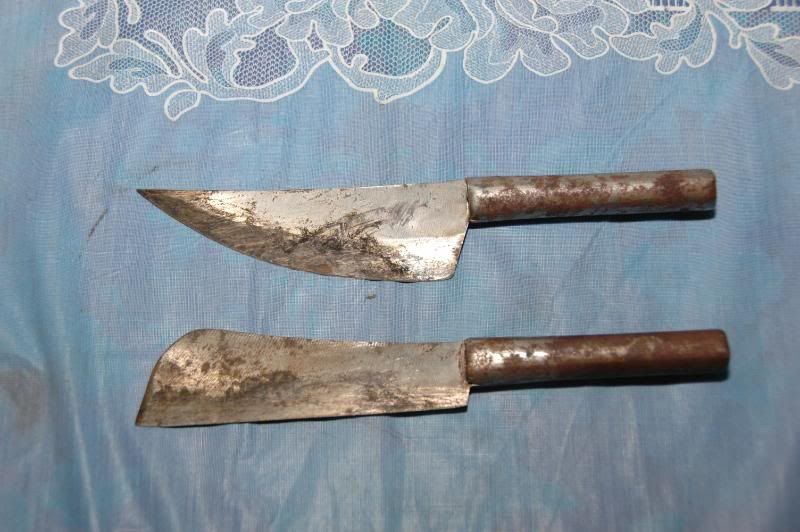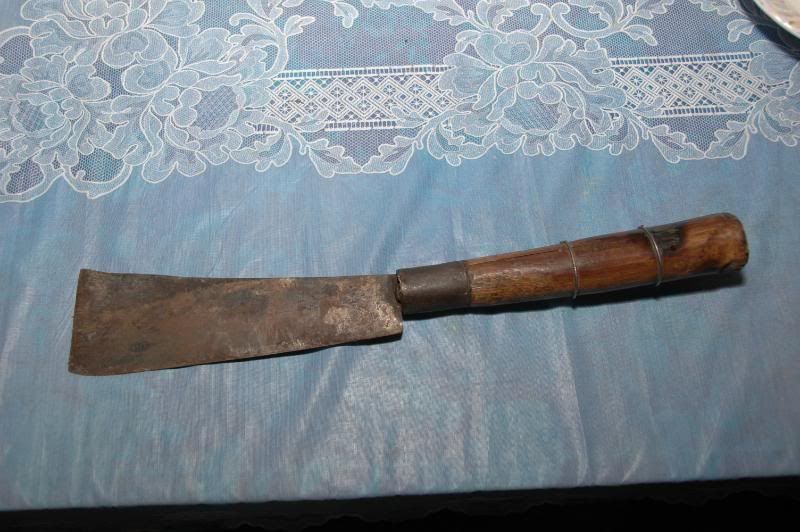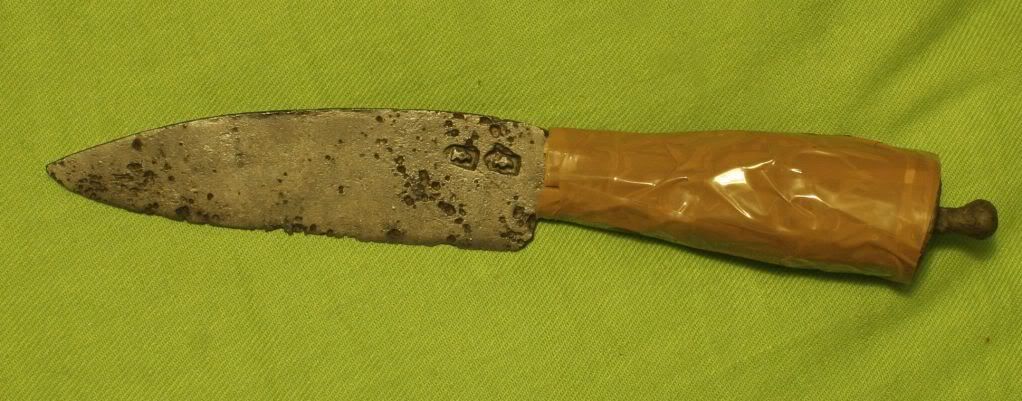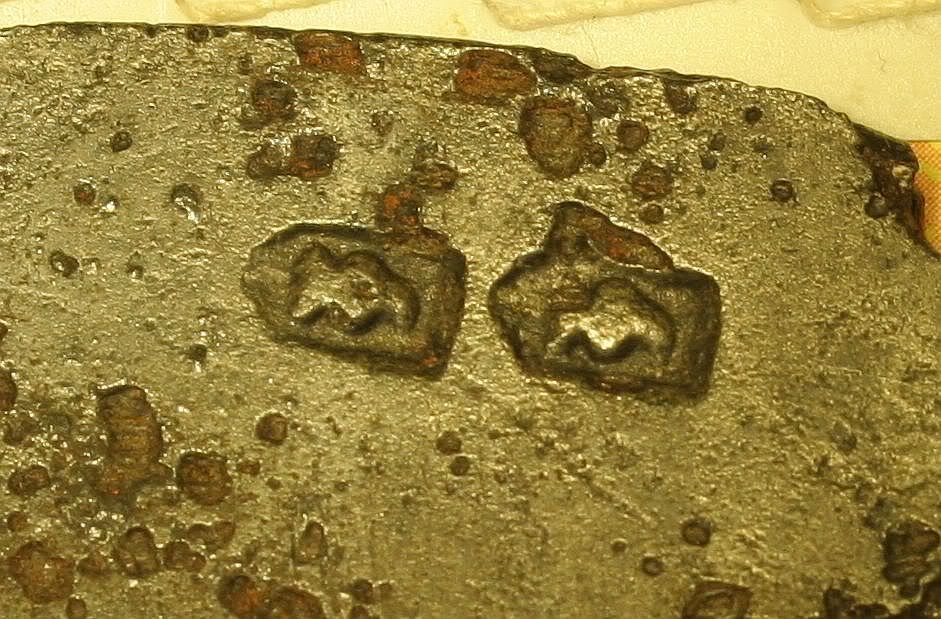
 |
|
|
#1 |
|
Member
Join Date: Aug 2007
Posts: 865
|
Anyone have some examples of ethnographic kitchen/ cooking knives?
I thought it would be interesting to see different cooking knives from around the world and through history? |
|
|

|
|
|
#2 |
|
Vikingsword Staff
Join Date: Nov 2004
Posts: 6,378
|
Why, as a matter of fact I have one .
 With pamor .  (pictures shortly) Last edited by Rick; 22nd August 2009 at 08:47 PM. |
|
|

|
|
|
#3 |
|
Member
Join Date: Aug 2007
Posts: 865
|
Very nice Rick, where is it from?
|
|
|

|
|
|
#4 |
|
Member
Join Date: Dec 2006
Posts: 102
|
Hi Nathaniel
I sent you a PM but your box is full. Cheers Jason |
|
|

|
|
|
#5 |
|
Vikingsword Staff
Join Date: Nov 2004
Posts: 6,378
|
Hi Nathaniel , this knife is from rural Java .
It is displayed on a 8x11 sheet of paper . Very sharp, feels good in the hand . The 'pamor' in this case seems to be just layers on a core; doubtful there is any esoteric intent . 
|
|
|

|
|
|
#6 |
|
Member
Join Date: May 2006
Posts: 7,134
|
Single knife is Japanese overall length 8.25".
Group of knives Jawa and Bali, key for comparison. All knives in current everyday use. |
|
|

|
|
|
#7 |
|
Member
Join Date: Dec 2004
Location: What is still UK
Posts: 5,935
|
Banks Island, Vanuatu, 54cm long. This is an eating knife rather than a kitchen knife. Probably for cutting and dividing prepared food and bring food to the mouth. Heavy foodstuff would be cut with larger bamboo knives even able to cut flesh.
|
|
|

|
|
|
#8 |
|
Member
Join Date: Dec 2004
Location: Ann Arbor, MI
Posts: 5,503
|
Come to think of it, Persian Kards, with their wootz blades and precious handles, are nothing but eating implements. They are mechanically not good for anything else.
|
|
|

|
|
|
#9 |
|
Member
Join Date: Oct 2008
Location: Manila, Phils.
Posts: 1,042
|
Below are examples from the Filipino Bajau Laut [pronounced bah-JOU (as in joust) LAH-oot], who live in southernmost Philippines (adjacent to Sabah/ Borneo, Malaysia).
Sorry for the poor quality of the pics. It's a cellphone camera I used. The items are displayed at the Phil. National Museum. The wooden knife says "spatula" on the label. The other item is labeled "axe", or "palakul" in the native tongue. Note how these folks can't help but make even everyday items very ornate ... |
|
|

|
|
|
#10 |
|
Member
Join Date: Sep 2005
Location: Left Coast, USA
Posts: 14
|
Eastern Arctic, Inuit: Nunavimiut, 1900-1909, Antler, metal, 5.3 x 6.4 cm (From McCord Museum).
Canadian Inuit, ("Thule"), Ulu (woman's knife), bone handle and iron blade, Strathcona Sound, Baffin Island, Nunavut, circa 1500-1800 A.D. (From the Canadian Museum of Civilization). While most of the earliest samples have slate blades (as illustrated below, from Afognak Data Recovery Project, Afgonak Island, Kodiak Archipelago), there is evidence that some of these peoples used meteoric iron and iron acquired from Norse adventurers as much as 1000 years ago, working it by cold hammering. They are still a very popular kitchen tool and modern samples abound. |
|
|

|
|
|
#11 | |
|
Member
Join Date: Dec 2004
Posts: 1,247
|
Quote:
|
|
|
|

|
|
|
#12 |
|
Member
Join Date: Dec 2004
Location: What is still UK
Posts: 5,935
|
Also better to cut up meat with mittens on your hands.
|
|
|

|
|
|
#13 |
|
Member
Join Date: Dec 2004
Posts: 987
|
Here's one with some age on it. Not exactly "kitchen" (open-air butcher shop, perhaps). It is an Acheulean hand-axe found along a river bed in central Ethiopia. Its about 5 inches long and 3 wide, and upwards of 1.5 million years old. Its quite something to hold, considering that the guy who made it wasn't even fully human (probably Homo erectus).
|
|
|

|
|
|
#14 |
|
Member
Join Date: May 2006
Posts: 7,134
|
Here's another Jawa kitchen knife.
This is my wife's mincer, for making big pieces of meat into smaller pieces. Weight 600grms, overall length 14.5" Made in Koripan, Jawa Tengah. |
|
|

|
|
|
#15 | |
|
Member
Join Date: Dec 2004
Posts: 1,247
|
Quote:
Ummm Mark, Are you saying that you use this in your kitchen??? 
|
|
|
|

|
|
|
#16 | |
|
Member
Join Date: Dec 2004
Posts: 987
|
Quote:

|
|
|
|

|
|
|
#17 |
|
Member
Join Date: Oct 2008
Posts: 53
|
ive seen kitchen knives with yataghan "ears" before
|
|
|

|
|
|
#18 |
|
Member
Join Date: Nov 2006
Posts: 400
|
In the province "Zeeland" ( south west Netherlands ) it was custom for every man to have his own "Paeremes". A traditionally carved knife for table,kitchen and other use and part of the local dress especially on sunday.
knifes where also give to a bride and groom on the weddingparty. The horse knifes where mostly carved by a local carver and a knife was always decorated on top with two horses between each other. most knife date from the period 1700-1900 often the knife are dated into the carving. They are quite expensive especially the older ones. The art of carving these knifes is almost gone and as far as I know there's only one old man who carves sometimes one. As son of a Zeeuw I'm thinking to pick up the production of these knifes,just to save the art for the future..... Arjan |
|
|

|
|
|
#19 |
|
Member
Join Date: Dec 2004
Location: What is still UK
Posts: 5,935
|
A Lapp knife {to cut the dancers two piece free, no thats just silly} food knife. The bone blade is smoothly polished with use and hard to photograph. Must have been a big spender
 . .
|
|
|

|
|
|
#20 |
|
Member
Join Date: Aug 2007
Posts: 865
|
 
|
|
|

|
|
|
#21 |
|
Member
Join Date: Oct 2008
Location: Manila, Phils.
Posts: 1,042
|
I think blades C & D can be deemed as kitchen knives ... from Fay-Cooper Cole's The wild tribes of Davao district, Mindanao (1913):
|
|
|

|
|
|
#22 | |
|
Member
Join Date: Jan 2005
Posts: 478
|
Quote:
|
|
|
|

|
|
|
#23 |
|
Member
Join Date: Dec 2004
Location: Santa Barbara, California
Posts: 301
|
On a tour, I stopped in a large outdoor market in Chang Mai. A butcher there was using this, or something like it. I knew I had to have one.
Couple of days later I stopped along the road in a little village where they specialize in blacksmithing. One of the smiths was just putting the finishing touches on this. 16 inches long, blade 9 inches long, 3 inches wide. it weighs 1 1/2 solid pounds. And yes, I do use it occasionally. The last time I used it was to take apart a large fish. Heavy blade. The spine is a quarter of an inch thick at the handle. It can be used as a throwing knife too, since it's heavy enough that no matter how it hits it'll hurt! |
|
|

|
|
|
#24 |
|
Member
Join Date: Dec 2005
Location: Silesia, Poland
Posts: 41
|
I cut meat with flint knives today. They are replicas of neolithic knives from Central Europe. Flint cuts like nothing else - really outstanding experience.
 http://www.youtube.com/watch?v=1TNAVykyePc |
|
|

|
|
|
#25 |
|
Member
Join Date: May 2006
Posts: 7,134
|
MROSS
No, made from a truck spring. Re flint knives I understand that a few years ago --- perhaps around 1990 --- there was a preference amongst some surgeons for knapped flint blades for some surgical procedures. I do not know if this still applies. |
|
|

|
|
|
#26 |
|
Member
Join Date: Dec 2005
Location: Silesia, Poland
Posts: 41
|
Recently I bought on a flea market in Poland such a knife:
[IMG]  [/IMG] [/IMG] It is 33cm (13inches) long and weighs 380g (13.5oz). Handle is made of horn. No idea how old is it and what is the provenance? |
|
|

|
|
|
#27 |
|
Member
Join Date: Dec 2005
Location: Silesia, Poland
Posts: 41
|
This piece comes from Bavaria, Southern Germany. It was made in 1400s (?) and is in a pretty nice shape. I almost think of sharpening it. I made a temporary hilt out of paper and some tape just to get feel of it. It is 22cm long (8.5 inches). I think it could be a nice kitchen or personal knife. What could be an original shape of the handle???[IMG]
 [/IMG] [/IMG]  What could be these maker`s marks? |
|
|

|
|
|
#28 | |
|
Member
Join Date: Aug 2007
Posts: 865
|
Quote:
http://www.youtube.com/watch?v=Tcgt_NsPq3w |
|
|
|

|
|
|
#29 |
|
Member
Join Date: Mar 2012
Posts: 422
|
A couple of traditional Korean kitchen knives. The larger one is modern, traditional style, forged from railway sleeper steel. It's inspired by the successful drama series http://en.wikipedia.org/wiki/Dae_Jang_Geum about a Korean woman who became a palace cook.
The smaller one is, I think, an antique Korean kitchen knife. The handle is natural wood, and ergonomically chosen. I haven't used this one yet. The modern one is a nice kitchen knife. A few weeks ago, I gave it a quick sandpaper sharpen; before that, it just had the original edge. It was nice and sharp before; now it is nice and very sharp. The last time I used it, I cooked an ancient Babylonian lunch. My main knife block is populated by mostly Japanese knives. I need to make a larger block that fits my Chinese knives. I don't think of those as ethnographic, but just another style of modern kitchen knife. Korean knives, OTOH, don't seem to be used in modern Korean kitchens. |
|
|

|
 |
|
|